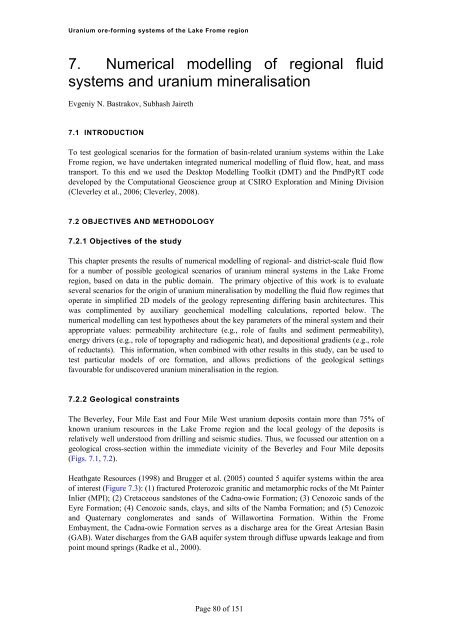Uranium ore-forming systems of the - Geoscience Australia
Uranium ore-forming systems of the - Geoscience Australia
Uranium ore-forming systems of the - Geoscience Australia
Create successful ePaper yourself
Turn your PDF publications into a flip-book with our unique Google optimized e-Paper software.
<strong>Uranium</strong> <strong>ore</strong>-<strong>forming</strong> <strong>systems</strong> <strong>of</strong> <strong>the</strong> Lake Frome region7. Numerical modelling <strong>of</strong> regional fluid<strong>systems</strong> and uranium mineralisationEvgeniy N. Bastrakov, Subhash Jaireth7.1 INTRODUCTIONTo test geological scenarios for <strong>the</strong> formation <strong>of</strong> basin-related uranium <strong>systems</strong> within <strong>the</strong> LakeFrome region, we have undertaken integrated numerical modelling <strong>of</strong> fluid flow, heat, and masstransport. To this end we used <strong>the</strong> Desktop Modelling Toolkit (DMT) and <strong>the</strong> PmdPyRT codedeveloped by <strong>the</strong> Computational <strong>Geoscience</strong> group at CSIRO Exploration and Mining Division(Cleverley et al., 2006; Cleverley, 2008).7.2 OBJECTIVES AND METHODOLOGY7.2.1 Objectives <strong>of</strong> <strong>the</strong> studyThis chapter presents <strong>the</strong> results <strong>of</strong> numerical modelling <strong>of</strong> regional- and district-scale fluid flowfor a number <strong>of</strong> possible geological scenarios <strong>of</strong> uranium mineral <strong>systems</strong> in <strong>the</strong> Lake Fromeregion, based on data in <strong>the</strong> public domain. The primary objective <strong>of</strong> this work is to evaluateseveral scenarios for <strong>the</strong> origin <strong>of</strong> uranium mineralisation by modelling <strong>the</strong> fluid flow regimes thatoperate in simplified 2D models <strong>of</strong> <strong>the</strong> geology representing differing basin architectures. Thiswas complimented by auxiliary geochemical modelling calculations, reported below. Thenumerical modelling can test hypo<strong>the</strong>ses about <strong>the</strong> key parameters <strong>of</strong> <strong>the</strong> mineral system and <strong>the</strong>irappropriate values: permeability architecture (e.g., role <strong>of</strong> faults and sediment permeability),energy drivers (e.g., role <strong>of</strong> topography and radiogenic heat), and depositional gradients (e.g., role<strong>of</strong> reductants). This information, when combined with o<strong>the</strong>r results in this study, can be used totest particular models <strong>of</strong> <strong>ore</strong> formation, and allows predictions <strong>of</strong> <strong>the</strong> geological settingsfavourable for undiscovered uranium mineralisation in <strong>the</strong> region.7.2.2 Geological constraintsThe Beverley, Four Mile East and Four Mile West uranium deposits contain m<strong>ore</strong> than 75% <strong>of</strong>known uranium resources in <strong>the</strong> Lake Frome region and <strong>the</strong> local geology <strong>of</strong> <strong>the</strong> deposits isrelatively well understood from drilling and seismic studies. Thus, we focussed our attention on ageological cross-section within <strong>the</strong> immediate vicinity <strong>of</strong> <strong>the</strong> Beverley and Four Mile deposits(Figs. 7.1, 7.2).Heathgate Resources (1998) and Brugger et al. (2005) counted 5 aquifer <strong>systems</strong> within <strong>the</strong> area<strong>of</strong> interest (Figure 7.3): (1) fractured Proterozoic granitic and metamorphic rocks <strong>of</strong> <strong>the</strong> Mt PainterInlier (MPI); (2) Cretaceous sandstones <strong>of</strong> <strong>the</strong> Cadna-owie Formation; (3) Cenozoic sands <strong>of</strong> <strong>the</strong>Eyre Formation; (4) Cenozoic sands, clays, and silts <strong>of</strong> <strong>the</strong> Namba Formation; and (5) Cenozoicand Quaternary conglomerates and sands <strong>of</strong> Willawortina Formation. Within <strong>the</strong> FromeEmbayment, <strong>the</strong> Cadna-owie Formation serves as a discharge area for <strong>the</strong> Great Artesian Basin(GAB). Water discharges from <strong>the</strong> GAB aquifer system through diffuse upwards leakage and frompoint mound springs (Radke et al., 2000).Page 80 <strong>of</strong> 151
















